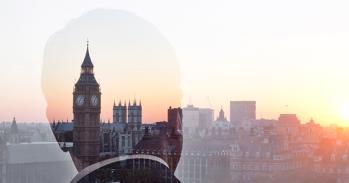With the Houses of Parliament requiring costly renovation, new research suggests we may have something to learn from plans in the 1730s to rebuild the Palace of Westminster.
With the Houses of Parliament requiring costly renovation, new research suggests we may have something to learn from plans in the 1730s to rebuild the Palace of Westminster.
We see Kent introduce increasingly spiky structures: an interesting melding of a pictorial notion of the gothic steeple, rendered in classical form
Frank Salmon
It was a decade that has some resonance for contemporary London. At the end of a 20-year building boom, London was sprawling outwards and soaring upwards. Its skyline was punctuated by imposing new structures juxtaposed with ramshackle old buildings – including the rambling, crumbling Palace of Westminster. So in 1733, William Kent, influential landscape gardener, designer and architect, was commissioned to design a more spacious and convenient “Edifice that may be made use of for the Reception of the Parliament.”
Over the course of the next decade, Kent submitted a succession of plans ranging from a complete rebuild to a salvage operation. They came to nothing. By 1742, the coffers had been drained by war with Spain and British embroilment in the War of Austrian Succession. Kent’s political champion, Prime Minister Robert Walpole – advocate of the Palladian style of architecture appropriated by the Whigs to articulate the values of order, reason and clarity to which they aspired – was toppled.
But Kent’s legacy of 80 drawings, suggests art historian Dr Frank Salmon, might in some respects represent the best Houses of Parliament the ‘Mother of all Parliaments’ never had. Salmon’s analysis of these meticulously drafted documents has, moreover, led him to revise his convictions about good public architecture, and its perception in Georgian Britain.
“Unusually for a Royal commission, there are few supporting documents save for two letters from the Office of Works,” explained Salmon. So the research required close interrogation of the drawings themselves, which are dispersed over four sites in London. “A lot of the work involved measurement: the architect, after all, will have been thinking in three dimensions, in the context of how the building will fit onto the ground.”
So what can we glean from Salmon’s reconstruction – and deconstruction – of Kent’s symmetrical arrangements of Corinthian columns, pediments, Venetian windows, white Portland Stone rusticated ground floors and imposing first floors that typify English Palladianism?
To an extent that has challenged Salmon’s conception of attitudes to preservation in the 18th century, Kent’s Houses of Parliament would have been charged with symbolism in a way we tend to associate with a late 19th-century concern with loss of heritage. “In most of his schemes, Kent retained the ancient Court of Requests,” said Salmon, “a medieval foundation that gave people instant access to justice without great cost. It had ceased to function during the Civil War, so he was introducing to a new building a redundant institution which, in one set of plans, would have been almost as big as the Hall of Mirrors at Versailles. Lost to us now, it must have symbolised something cherished about British liberty.”
“In the first scheme, the book collection that today forms the nucleus of the British Library was to be an integral part of the building. Again, the idea of the nation’s intellectual capital being co-proximate with its centre of power is redolent with symbolism.”
Although too small to accommodate today’s Parliamentary business, Kent’s building would nevertheless have been imposing. At 444 ft long and parallel to the River Thames in one plan, its towering columns and dome would have dominated the city. In a later plan, with a huge central tower, it would have projected far enough into the Thames to require embankment. It would, for the first time, have presented the home of government as a unified entity.
At a time when the Commons was beginning to sit along party lines, “Kent’s Commons would have been amphitheatrical, although he retained the biaxial Lords,” said Salmon. “In one plan, a section of seats was angled, perhaps set aside for the Cabinet.” In what seems a strikingly literal assertion of authority, the Speaker’s throne protruded into the middle of the Chamber. There would have been space for spectators; although, with a ban on Parliamentary reporting in the press reinforced in 1738, the purpose here is opaque.
Unlike Westminster today, where the labyrinthine corridors of power would stretch to three miles if placed end-to-end, Kent’s building would have been relatively easy to negotiate. Its classical proportions and suites of adjoining rooms would have made a virtue of light and space – for some: Salmon has discerned designs for communal toilets for male servants, in contrast with comparatively more luxurious accommodation above stairs.
If Kent’s existing Horse Guards building is anything to go by, his Parliament would have been relatively sustainable compared with today’s building, which presents a ‘looming crisis’ according to a recent Parliamentary Report, ridden with asbestos, with antiquated heating and drainage, and sinking into the ground.
As for Kent the architect, Salmon’s research represents a substantial reappraisal of Kent’s position in our cultural history. The exuberant, erratic parvenu of some depictions comes across as “a highly professional, competent architect rooted in reality”, according to Salmon, positioning facilities with a view to the paths that the myriad personnel who make up the ecology of parliament would need to trace through the building. Perhaps Kent’s charming habit of doodling in the margins of his plans the parliamentary personalities who populated his imagination helped make his architecture sympathetic to those who would inhabit it.
The plans evolved in a way that suggests that Kent was responsive, too, to the changing skyline. “Hawksmoor’s towers of Westminster Abbey were being built, and Archer’s St John’s, Smith Square, had been recently completed,” said Salmon. “Kent’s initial plan for a dome wouldn’t have held its own. So we see Kent introduce increasingly spiky structures: an interesting melding of a pictorial notion of the gothic steeple, rendered in classical form.”
Four years in the company of William Kent has led Salmon to re-evaluate his position on Palladian architecture – the style inspired by architect Andrea Palladio’s interpretation of classical Greek and Roman architecture. “I wanted to do this research to test my hypothesis that the Palladian style, so successful for country houses, was a dull subspecies of public architecture imposed on the country by the influential Lord Burlington and his friends. Kent’s Horse Guards building, for example, is really a version of a country house. When you consider its design in functional terms, however, of where the horses, foot soldiers, the ordnance, the barber, the coffee shop, the clerks would be situated, it all works perfectly, horizontally and vertically, in terms of the distribution of spaces. It seems that the way in which we have come to regard city and country as stylistically distinct as well as functionally so did not apply in the 18th century.”
“With historical research, it’s always good to have your hypothesis challenged by the evidence, because you know you’re nearer to the truth.”
Salmon’s research has recently been published by Yale University Press as part of a major retrospective on William Kent in the context of the tercentenary of the Hanoverian succession. Publication coincides with a substantial exhibition of Kent’s work at the Bard Center New York, which will move to the Victoria and Albert Museum in Spring 2014.
Pallid Palladianism or classy classicism? Members of the public will be able to assess for themselves the grand designs that would – architecturally – have brought a sense of proportion to Parliament.
Inset image: House of Lords (1735-6): British Architectural Library, Royal Institute of British Architects
This work is licensed under a Creative Commons Licence. If you use this content on your site please link back to this page.





